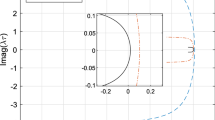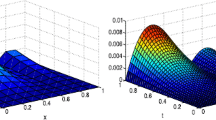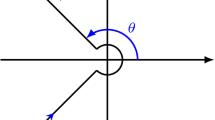Abstract
Thanks to the singularity of the solution of linear subdiffusion problems, most time-step** methods on uniform meshes can result in \(O(\tau )\) accuracy where \(\tau \) denotes the time step. The present work aims to discover the reason why some type of Crank-Nicolson schemes (the averaging Crank-Nicolson (ACN) scheme) for the subdiffusion can only yield \(O(\tau ^\alpha )\,\, (\alpha <1)\) accuracy, which is much lower than the desired. The existing well-developed error analysis for the subdiffusion, which has been successfully applied to many time-step** methods such as the fractional BDF-\(p\,\,(1\leqslant p\leqslant 6)\), requires singular points to be out of the path of contour integrals involved. The ACN scheme in this work is quite natural but fails to meet this requirement. By resorting to the residue theorem, some novel sharp error analysis is developed in this study, upon which correction methods are further designed to obtain the optimal \(O(\tau ^2)\) accuracy. All results are verified by numerical tests.



Similar content being viewed by others
Data Availability
The data that support the findings of this study are available from the corresponding author, upon reasonable request.
References
Alikhanov, A.A.: A new difference scheme for the time fractional diffusion equation. J. Comput. Phys. 280, 424–438 (2015)
Barkai, E., Metzler, R., Klafter, J.: From continuous time random walks to the fractional Fokker-Planck equation. Phys. Rev. E 61(1), 132 (2000)
Chen, H., Stynes, M.: Error analysis of a second-order method on fitted meshes for a time-fractional diffusion problem. J. Sci. Comput. 79, 624–647 (2019)
Chen, S., Shen, J., Zhang, Z., Zhou, Z.: A spectrally accurate approximation to subdiffusion equations using the log orthogonal functions. SIAM J. Sci. Comput. 42(2), A849–A877 (2020)
Dimitrov, Y.: Numerical approximations for fractional differential equations. ar**v:1311.3935 (2013)
Gao, G.H., Sun, H.W., Sun, Z.Z.: Stability and convergence of finite difference schemes for a class of time-fractional sub-diffusion equations based on certain superconvergence. J. Comput. Phys. 280, 510–528 (2015)
Golding, I., Cox, E.C.: Physical nature of bacterial cytoplasm. Phys. Rev. Lett. 96(9), 098102 (2006)
**, B., Lazarov, R., Zhou, Z.: Error estimates for a semidiscrete finite element method for fractional order parabolic equations. SIAM J. Numer. Anal. 51(1), 445–466 (2013)
**, B., Li, B., Zhou, Z.: Correction of high-order BDF convolution quadrature for fractional evolution equations. SIAM J. Sci. Comput. 39(6), A3129–A3152 (2017)
**, B., Li, B., Zhou, Z.: An analysis of the Crank-Nicolson method for subdiffusion. IMA J. Numer. Anal. 38(1), 518–541 (2018)
Kilbas, A.A., Srivastava, H.M., Trujillo, J.J.: Theory and Applications of Fractional Differential Equations, vol. 204. Elsevier, London (2006)
Kopteva, N.: Error analysis of the L1 method on graded and uniform meshes for a fractional-derivative problem in two and three dimensions. Math. Comput. 88(319), 2135–2155 (2019)
Li, C., Zeng, F.: Numerical Methods for Fractional Calculus, vol. 24. CRC Press, New York (2015)
Li, D., Sun, W., Wu, C.: A novel numerical approach to time-fractional parabolic equations with nonsmooth solutions. Numer. Math. Theor. Methods Appl. 14(2), 355–376 (2021)
Liao, H.L.: A second-order scheme with nonuniform time steps for a linear reaction-subdiffusion problem. Commun. Comput. Phys. 30(2), 567–601 (2021)
Liao, H.L., Li, D., Zhang, J.: Sharp error estimate of the nonuniform L1 formula for linear reaction-subdiffusion equations. SIAM J. Numer. Anal. 56(2), 1112–1133 (2018)
Lin, Y., Xu, C.: Finite difference/spectral approximations for the time-fractional diffusion equation. J. Comput. Phys. 225(2), 1533–1552 (2007)
Liu, Y., Yin, B., Li, H., Zhang, Z.: The unified theory of shifted convolution quadrature for fractional calculus. J. Sci. Comput. 89(1), 18 (2021)
Lubich, C.: Discretized fractional calculus. SIAM J. Math. Anal. 17(3), 704–719 (1986)
Magin, R.: Fractional calculus in bioengineering, part 1. Crit. Rev. Bioeng. 32(1), 33 (2004)
Raberto, M., Scalas, E., Mainardi, F.: Waiting-times and returns in high-frequency financial data: an empirical study. Phys. A 314(1–/2/3/4), 749–755 (2002)
Sakamoto, K., Yamamoto, M.: Initial value/boundary value problems for fractional diffusion-wave equations and applications to some inverse problems. J. Math. Anal. Appl. 382(1), 426–447 (2011)
Shi, J., Chen, M., Yan, Y., Cao, J.: Correction of high-order \(L_k\) approximation for subdiffusion. J. Sci. Comput. 93(1), 31 (2022)
Stynes, M.: Too much regularity may force too much uniqueness. Frac. Calc. Appl. Anal. 19(6), 1554–1562 (2016)
Stynes, M., O’Riordan, E., Gracia, J.L.: Error analysis of a finite difference method on graded meshes for a time-fractional diffusion equation. SIAM J. Numer. Anal. 55(2), 1057–1079 (2017)
Sun, Z.Z., Wu, X.: A fully discrete difference scheme for a diffusion-wave system. Appl. Numer. Math. 56(2), 193–209 (2006)
Wang, J., Wang, J., Yin, L.: A single-step correction scheme of Crank-Nicolson convolution quadrature for the subdiffusion equation. J. Sci. Comput. 87(1), 26 (2021)
Wang, Y., Yan, Y., Yan, Y., Pani, A.K.: Higher order time step** methods for subdiffusion problems based on weighted and shifted Grünwald-Letnikov formulae with nonsmooth data. J. Sci. Comput. 83(3), 40 (2020)
Yan, Y., Khan, M., Ford, N.J.: An analysis of the modified L1 scheme for time-fractional partial differential equations with nonsmooth data. SIAM J. Numer. Anal. 56(1), 210–227 (2018)
Yin, B., Liu, Y., Li, H.: Necessity of introducing non-integer shifted parameters by constructing high accuracy finite difference algorithms for a two-sided space-fractional advection-diffusion model. Appl. Math. Lett. 105, 106347 (2020)
Yin, B., Liu, Y., Li, H., Zhang, Z.: Efficient shifted fractional trapezoidal rule for subdiffusion problems with nonsmooth solutions on uniform meshes. BIT 62(2), 631–666 (2022)
Zaslavsky, G.M.: Chaos, fractional kinetics, and anomalous transport. Phys. Rep. 371(6), 461–580 (2002)
Zeng, F., Li, C., Liu, F., Turner, I.: Numerical algorithms for time-fractional subdiffusion equation with second-order accuracy. SIAM J. Sci. Comput. 37(1), A55–A78 (2015)
Acknowledgements
This work is supported by the Autonomous Region Level High-Level Talent Introduction Research Support Program in 2022 (No. 12000-15042224 to B.Y.), the National Natural Science Foundation of China (No. 12201322 to B.Y., 12061053 to Y.L., and 12161063 to H.L.), and the Natural Science Foundation of Inner Mongolia, China (No. 2020MS01003 to Y.L. and 2021MS01018 to H.L.).
Author information
Authors and Affiliations
Corresponding author
Ethics declarations
Conflict of Interest
The authors declare that they have no conflict of interest.
Rights and permissions
Springer Nature or its licensor (e.g. a society or other partner) holds exclusive rights to this article under a publishing agreement with the author(s) or other rightsholder(s); author self-archiving of the accepted manuscript version of this article is solely governed by the terms of such publishing agreement and applicable law.
About this article
Cite this article
Yin, B., Liu, Y. & Li, H. Sharp Error Analysis for Averaging Crank-Nicolson Schemes with Corrections for Subdiffusion with Nonsmooth Solutions. Commun. Appl. Math. Comput. (2024). https://doi.org/10.1007/s42967-024-00401-1
Received:
Revised:
Accepted:
Published:
DOI: https://doi.org/10.1007/s42967-024-00401-1




